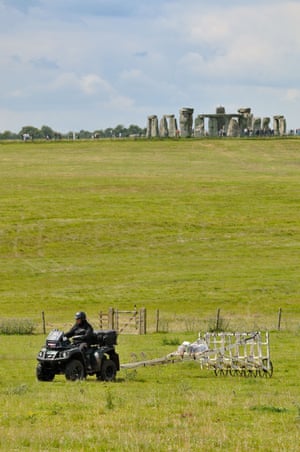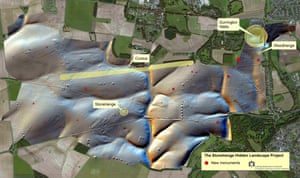考古學家對英國巨石陣的研究越是深入,揭開的謎團就越多,但是,一個完整的故事也在顯現。
http://bbc.in/2DUyvBo
http://bbc.in/2DUyvBo
......"在巨石陣似乎總有新的發現,但我對我們能有如此多的發現還是感到驚訝——即使那些已被研究多年的區域也不例外,"加夫尼說。"杜靈頓的最新發現表明,借助新技術不僅能發現新的遺跡,還能極大地改變我們對已知遺跡的認知。
"它強調的不只是巨石陣本身的獨特性,而是它周圍的遺跡同樣重要——我們只是剛剛開始理解它的發展以及它對於巨石陣建造者們的意義所在。"
即便如此,無論有多少新發現,巨石陣似乎還會不斷拋出新的問題,引發科學家和媒體的思索。這些新石器時代的人類已經擁有了不起的技巧和雄心。
如此巨大的紀念碑以如此完美的方式樹立,歷經千年依然屹立不倒,這對於我們生活節奏飛快的現代人來說,想要理解並不容易。
請訪問BBC Travel閲讀英文原文
Spectrum | 30.09.2008 | 04:30
The Stonehenge Mystery

Großansicht des Bildes mit der Bildunterschrift:
British archaeologists say they have taken a major step towards solving one of the UK ’s deepest mysteries: when and why was Stonehenge built?
The prehistoric stone monument has been an object of fascination…and bafflement for centuries. But now - using the latest technology – scientists have come up with some answers. They have found that the site isn’t as old as was originally thought. And they say Stonehenge may not have been primarily a burial ground…but an ancient hospital instead. Stephen Beard reports.
Wikipedia article "Stonehenge".
Stonehenge
(stōn'hĕnj')

A group of standing stones on Salisbury Plain in southern England. Dating to c. 2000–1800 B.C., the megaliths are enclosed by a circular ditch and embankment that may date to c. 2800. The arrangement of the stones suggests that Stonehenge was used as a religious center and also as an astronomical observatory.
━━ n. ストーンヘンジ ((イングランド南部のSalisbury平原の巨石柱群)).
A henge is a prehistoric architectural structure. In form, it is a nearly circular or oval-shaped flat area over 20 metres (65 feet) in diameter that is enclosed and delimited by a boundary earthwork that usually comprises a ditch with an external bank. The earthwork permits access to the interior by one, two, or four entrances. Internal components may include portal settings, timber circles, post rings, stone circles, four-stone settings, monoliths, standing posts, pits, coves, post alignments, stone alignments, burials, central mounds, and stakeholes (English Heritage definition).
英國巨石陣 可能是墓地
【聯合報╱記者李承宇/台北報導】
2008.05.30 02:44 am
考古團隊在英國巨石陣附近挖掘出新石器時代的村落遺址,從出土的遺骸可推估,巨石陣最早的功用是作為墓地。
圖/國家地理頻道提供
這項發現絕對比印第安那瓊斯的電影更讓人驚奇。
英國學者皮爾森(Mike Parker Pearson)率領的考古團隊,在英國神秘的史前巨石陣遺跡發現一個新石器時代村落遺址,藉由放射性碳定年後,推論巨石陣的最早用途不是天文觀測工具、不是宗教祭祀場所,而是一處墓地。
英國巨石陣位於倫敦西南方,由數十塊巨大的石塊組成,最重的石塊將近五十噸,巨石陣的用途長久以來是考古學界的謎團。皮爾森在國家地理雜誌的「巨石陣河岸 計畫」資助下,挖掘出新石器時代的村落遺址,這個村落約有三百間房屋,是西北歐洲新石器時代最大的聚落。皮爾森昨天在英國透過視訊會議,向全球公布這項新 發現。
在巨石遺跡中有一些火葬坑,皮爾森利用放射性碳定年技術,測出火葬坑中的骸骨年代約在西元前三千年,與巨石陣形成的時間相同。皮爾森因此推斷,巨石陣「是供祖先亡靈休憩的住所」,建造的主要功能是作為墓葬之用。
他表示,埋在巨石遺跡中的人數不多,且陪葬文物裡有一些石頭雕刻的權杖出土,「這些人可能是當時村落中的菁英階級或統治者」,他並認為,這些人埋在如此重要的紀念象徵物底下,「絕對不是普通人。」
其實早在一九三五年,考古學界就在巨石陣中挖掘出墓葬,但不為當時學界重視,認為沒有科學上的價值。後世考古學者都推測這些墓葬的年代大約在西元前廿七到 廿八世紀。這次皮爾森首次利用放射性碳定年,把墓葬的年代往前推了五百年,與巨石建築時間相仿,因此他推測巨石可能是這些墓葬的紀念碑,而建造者就是這個 村落的居民。
皮爾森表示,巨石陣應該是那個時代最大的墓園,六百年間約有二百四十人埋葬其中,包括自然死亡的男性、女性以及小孩。
.這項考古學界重大發現,國家地理頻道將在九月六日的節目「千古疑雲巨石陣」中,在台首播。
Dry spell at Stonehenge reveals secret that has eluded archaeologists
Brown patches of grass left by short hosepipe lead to 'lightbulb moment' that may confirm monument was once a perfect circle
Share2339
Steven Morris
The Guardian, Monday 1 September 2014 17.19 BST
Jump to comment (33)

An orthophoto of Stonehenge taken from the air shows the brown patches of grass where stones may once have completed the circle. Photograph: English Heritage/Damian Grady
One of the many mysteries of Stonehenge may have been solved, not because of a scientific breakthrough or painstaking research, but after a maintenance team's hosepipe turned out to be a little short.
Archaeologists have long argued over whether the ancient monument was once a perfect circle or if it was always, as it is now, an incomplete ring.
When a hosepipe used to keep the grass green in hot spells failed to reach a broken part of the circle, unsightly brown patches began to appear. Custodian Tim Daw was fretting over the blemishes when he realised they matched the spots where stones would probably have stood if the monument had been a complete circle.
Daw said it was a "lightbulb moment". "I was standing on the public path looking at the grass near the stones and thinking we needed to find a longer hosepipe to get the parched patches to green up," he said.
"I remembered that the marks were where archaeologists had looked without success for signs that there had been stone holes. I called my colleague over and he saw them and realised their possible significance as well. Not being archaeologists, we called in the professionals.
"I am still amazed, and very pleased, that simply looking at something that tens of thousands of people had unwittingly seen, can reveal secrets that sophisticated machinery can't."
The professionals duly took charge. Aerial photographs were hurriedly commissioned before the rain could come and remove the brown patches, and the scorch marks on the western side of the Wiltshire site were mapped, and some of the brown patches indeed tallied with where stones would have stood if the circle were complete.
Other brown patches corresponded to recorded archaeological excavations, included trenches dug by the engineer William Gowland in 1901. That some of the patches matched the site of the trenches supports the theory that they indicate disturbed ground.
The patches were spotted last summer, but the conclusions have just been detailed in a report by Daw and other English Heritage staff published in the latest edition of the journal Antiquity. The report points out that, despite being one of the most intensively explored prehistoric monuments, Stonehenge continues to hold surprises. It also highlights the value of continually surveying the site from the ground and air.
Susan Greaney, senior properties historian for English Heritage, said the accidental discovery was "really significant" and added: "It shows us just how much we still have to learn about Stonehenge. It's great that people who know the site really well and look at it every day were able to spot these parch marks and recognise them for what they were."
Greaney said what might have happened to the missing stones remained a puzzle. They could have been removed and used as stone for local houses or even roads. But the lack of a decent-sized hosepipe means the idea that the circle was deliberately left incomplete can probably be discounted.
There are no plans to excavate beneath the brown marks, but English Heritage, which manages Stonehenge, may deliberately fail to water parts of the site next time there is a hot spell in case other mysteries can be solved.
******
'Archaeology on steroids': huge ritual arena discovered near Stonehenge
Researchers find hidden remains of massive Neolithic stone monument, thought to have been hauled into position more than 4,500 years ago
 Artist’s impression showing how the Durrington Walls monoliths might have looked more than 4,500 years ago. Photograph: Ludwig Boltzmann Institute/Briti/PA
Artist’s impression showing how the Durrington Walls monoliths might have looked more than 4,500 years ago. Photograph: Ludwig Boltzmann Institute/Briti/PAIan Sample Science editor
@iansample
Monday 7 September 2015 00.01 BSTLast modified on Monday 7 September 201500.11 BST
Archaeologists have discovered the remains of a massive stone monument buried under a thick, grassy bank only two miles from Stonehenge.
The hidden arrangement of up to 90 huge standing stones formed part of a C-shaped Neolithic arena that bordered a dry valley and faced directly towards the river Avon.
Researchers used ground-penetrating radar to image about 30 intact stones measuring up to 4.5m tall. The fragments of 60 more buried stones, or the massive foundation pits in which they stood, reveal the full extent of the monument.

FacebookTwitterPinterest A hidden complex of archaeological monuments has been uncovered around Stonehenge using hi-tech methods of scanning below the Earth’s surface. Photograph: Ludwig Boltzmann Institute
“What we are starting to see is the largest surviving stone monument, preserved underneath a bank, that has ever been discovered in Britain and possibly in Europe,” said Vince Gaffney, an archaeologist at Bradford University who leads the Stonehenge Hidden Landscape project. “This is archaeology on steroids.”
 A motorized magnetometer system is used to survey the land around Stonehenge. Photograph: Geert Verhoeven/Stonehenge Hidden Landscape/PA
A motorized magnetometer system is used to survey the land around Stonehenge. Photograph: Geert Verhoeven/Stonehenge Hidden Landscape/PAThe stones are thought to have been hauled into position more than 4,500 years ago to form the southern edge of a ritual arena centred on a natural depression. The stones appear to have joined up with a chalk ridge that had been cut into the accentuate the natural border.
“We presume it to be a ritual arena of some sort,” said Gaffney, whose team has mapped the terrain and subsurface features around Stonehenge with a rich suite of instruments. He will describe the latest findings from the site on Monday at theBritish Science festival in Bradford.
Images of the buried stones show them lying down, but Gaffney believes they originally stood upright and were pushed over when the site was redeveloped by Neolithic builders. The recumbent stones became lost beneath a huge bank and were incorporated as a somewhat clumsy linear southern border to the otherwise circular “superhenge” known as Durrington Walls. “This is a new element of how the Stonehenge landscape was transformed.”
A mile in circumference, Durrington Walls is one of the largest known henge monuments. It is surrounded by a ditch and a 40m-wide, 1m-tall outer bank. The henge surrounds smaller enclosures and timber circles from a later settlement.
The Stonehenge Hidden Landscape project has transformed how archaeologists view the ancient site, which sprawls over 4 sq miles of Salisbury Plain in Wiltshire. The main monument stands at the heart of a landscape rich with burial grounds, pits and chapels. Last year, researchers found the remains of 17 new chapels and hundreds of other archaeological features scattered across the site.
Two huge pits have been discovered in a two mile-long monument called the Cursus that lies to the north of Stonehenge. The pits seem to form an astronomical arrangement: on midsummer’s day, the eastern pit’s alignment with the rising sun and the western pit’s alignment with the setting sun intersect where Stonehenge was built 400 years later.
The rise and fall of the newly discovered monument at Durrington Walls suggests that buildings were modified and recycled since the first stones were laid around 3100BC. A large timber building encased in chalk is thought to have been a house of the dead where defleshing was performed as a burial ritual.

FacebookTwitterPinterest The location of newly discovered monuments around Stonehenge. Photograph: Geert Verhoeven/Birmingham University/PA
Paul Garwood, an archaeologist and lead historian on the project at the University of Birmingham, said the the new discoveries at Durrington Walls changed fundamentally how researchers understood Stonehenge and the world around it. “Everything written previously about the Stonehenge landscape and the ancient monuments within it will need to be rewritten,” he said.
Nick Snashall, a National Trust archaeologist for the Avebury and Stonehenge world heritage site, said: “These latest results have produced tantalising evidence of what lies beneath the ancient earthworks at Durrington Walls. The presence of what appear to be stones, surrounding the site of one of the largest Neolithic settlements in Europe, adds a whole new chapter to the Stonehenge story.”

沒有留言:
張貼留言